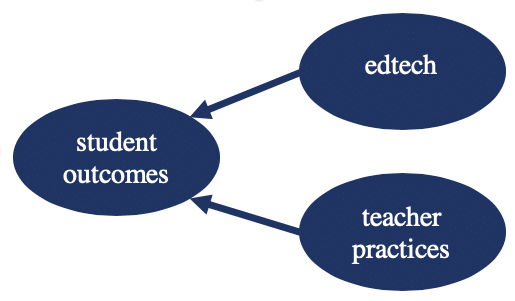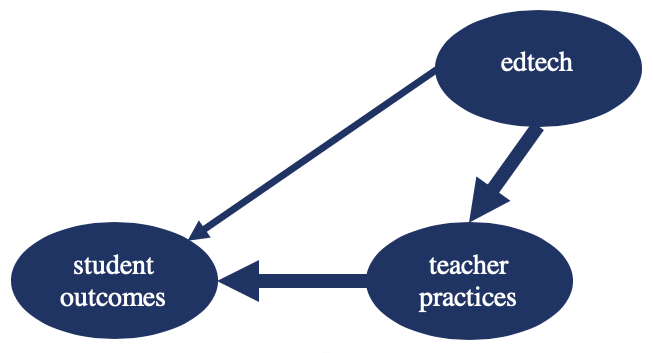Does adaptive learning software improve test scores? Does a 1:1 device initiative improve learning? Is screen time good for students? Questions like these are regulars in debates about edtech. But whether you’re an edtech advocate or a critic, if you’re asking questions like these, you’re missing the mark.
All of these questions stand atop an inaccurate edtech paradigm that more or less resembles the first diagram below. According to this paradigm, a school’s resources—edtech and teacher practices being two prime examples—each contributes to student outcomes. Therefore, improved student outcomes result from investing in the resources with the largest direct impact on student outcomes.

With this paradigm as a starting point, edtech critics look for evidence that technology’s impact is small or negative and therefore doesn’t warrant its cost. Meanwhile, edtech proponents, operating from the same paradigm, want to show that edtech is a student learning gamechanger that deserves space on a school’s schedule and budget.
But what this paradigm gets wrong is its assumption that edtech, teacher practices, and other resources have independent impacts on student learning. In reality, edtech not only influences student outcomes directly, but also has a potential indirect impact by enabling shifts in teachers’ practices, as this second diagram illustrates.

To make this second paradigm concrete, consider a few examples.
Online content playlists
Direct impact: Students gain additional access to course content, allowing them to explore that content in a format and at a pace that may be more conducive to their learning needs. (Essentially, online playlists add multimedia, easier access, and adaptability to a function that textbooks have served for centuries.)
Indirect impact: Using online playlists, teachers can shift their time and energy away from planning and delivering direct instruction to spend it instead on other valuable activities—such as facilitating projects, implementing mastery-based learning, giving students deeper feedback on their work, providing students with coaching or mentorship, facilitating opportunities to build students’ social capital, and building connections and partnerships with students’ families.
Adaptive learning software
Direct impact: Students gain exposure and practice with content targeted at their particular learning needs. As a result, students progress more rapidly in their learning by consistently working at their zone of proximal development.
Indirect impact: When teachers use the adaptive learning software as a learning activity in a new classroom model, such as a Station Rotation, it helps them create more opportunities for small-group instruction. Additionally, when the software provides teachers with real-time learning data in a user-friendly format, teachers can use that data to inform their student groupings and plan group lessons that are better targeted at students’ particular learning needs.
Essay grading software
Direct impact: Students get immediate feedback on the grammar, structure, and style of their writing assignments. Increased feedback allows them to more quickly internalize principles of good writing.
Indirect impact: With the help of essay grading software, students can address many writing issues before they share their writing with their teachers. When software helps students address issues like grammar, structure, and style, teachers can then focus more of their feedback on higher-order aspects of writing, such as reasoning, rhetoric, and appeal to an audience.
In truth, edtech’s indirect impact in most school settings is likely just as substantial as its direct impact. For evidence, consider Hattie’s research: the teaching practices edtech helps to enable have substantially more impact on student learning than stand-alone edtech interventions.
Yet when the prevailing paradigm for thinking about edtech resembles the first diagram above, edtech’s indirect impacts often get overlooked. For example, studies aimed at measuring the efficacy of an edtech resource miss that resource’s full impact when they fail to include shifts in teaching practices in their analysis. Similarly, when school leaders see edtech as merely another resource to purchase for boosting student learning, they often shortchange the change management, teacher development, and blended-learning implementation that need to go hand-in-hand with edtech adoption.
To capture edtech’s greatest benefits, we need to start with the right paradigm. Thus, in our conversations about edtech, let’s pull back on discussing whether edtech improves student learning and instead focus on how edtech can lead to better instruction by enabling shifts in teaching.



